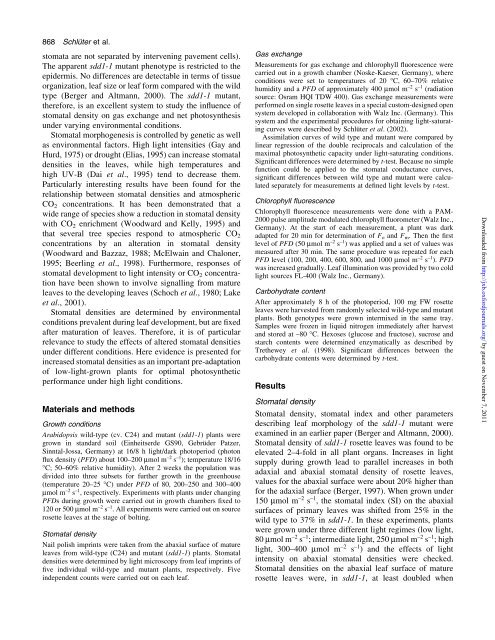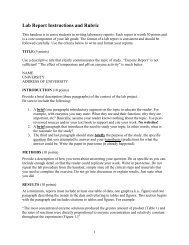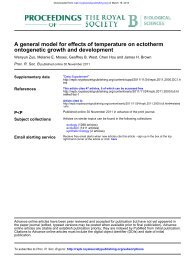under different light regimes - Biology Department
under different light regimes - Biology Department
under different light regimes - Biology Department
Create successful ePaper yourself
Turn your PDF publications into a flip-book with our unique Google optimized e-Paper software.
868 SchluÈter et al.<br />
stomata are not separated by intervening pavement cells).<br />
The apparent sdd1-1 mutant phenotype is restricted to the<br />
epidermis. No differences are detectable in terms of tissue<br />
organization, leaf size or leaf form compared with the wild<br />
type (Berger and Altmann, 2000). The sdd1-1 mutant,<br />
therefore, is an excellent system to study the in¯uence of<br />
stomatal density on gas exchange and net photosynthesis<br />
<strong>under</strong> varying environmental conditions.<br />
Stomatal morphogenesis is controlled by genetic as well<br />
as environmental factors. High <strong>light</strong> intensities (Gay and<br />
Hurd, 1975) or drought (Elias, 1995) can increase stomatal<br />
densities in the leaves, while high temperatures and<br />
high UV-B (Dai et al., 1995) tend to decrease them.<br />
Particularly interesting results have been found for the<br />
relationship between stomatal densities and atmospheric<br />
CO 2 concentrations. It has been demonstrated that a<br />
wide range of species show a reduction in stomatal density<br />
with CO 2 enrichment (Woodward and Kelly, 1995) and<br />
that several tree species respond to atmospheric CO2<br />
concentrations by an alteration in stomatal density<br />
(Woodward and Bazzaz, 1988; McElwain and Chaloner,<br />
1995; Beerling et al., 1998). Furthermore, responses of<br />
stomatal development to <strong>light</strong> intensity or CO 2 concentration<br />
have been shown to involve signalling from mature<br />
leaves to the developing leaves (Schoch et al., 1980; Lake<br />
et al., 2001).<br />
Stomatal densities are determined by environmental<br />
conditions prevalent during leaf development, but are ®xed<br />
after maturation of leaves. Therefore, it is of particular<br />
relevance to study the effects of altered stomatal densities<br />
<strong>under</strong> <strong>different</strong> conditions. Here evidence is presented for<br />
increased stomatal densities as an important pre-adaptation<br />
of low-<strong>light</strong>-grown plants for optimal photosynthetic<br />
performance <strong>under</strong> high <strong>light</strong> conditions.<br />
Materials and methods<br />
Growth conditions<br />
Arabidopsis wild-type (cv. C24) and mutant (sdd1-1) plants were<br />
grown in standard soil (Einheitserde GS90, GebruÈder Patzer,<br />
Sinntal-Jossa, Germany) at 16/8 h <strong>light</strong>/dark photoperiod (photon<br />
¯ux density (PFD) about 100±200 mmol m ±2 s ±1 ); temperature 18/16<br />
°C; 50±60% relative humidity). After 2 weeks the population was<br />
divided into three subsets for further growth in the greenhouse<br />
(temperature 20±25 °C) <strong>under</strong> PFD of 80, 200±250 and 300±400<br />
mmol m ±2 s ±1 , respectively. Experiments with plants <strong>under</strong> changing<br />
PFDs during growth were carried out in growth chambers ®xed to<br />
120 or 500 mmol m ±2 s ±1 . All experiments were carried out on source<br />
rosette leaves at the stage of bolting.<br />
Stomatal density<br />
Nail polish imprints were taken from the abaxial surface of mature<br />
leaves from wild-type (C24) and mutant (sdd1-1) plants. Stomatal<br />
densities were determined by <strong>light</strong> microscopy from leaf imprints of<br />
®ve individual wild-type and mutant plants, respectively. Five<br />
independent counts were carried out on each leaf.<br />
Gas exchange<br />
Measurements for gas exchange and chlorophyll ¯uorescence were<br />
carried out in a growth chamber (Noske-Kaeser, Germany), where<br />
conditions were set to temperatures of 20 °C, 60±70% relative<br />
humidity and a PFD of approximately 400 mmol m ±2 s ±1 (radiation<br />
source: Osram HQI TDW 400). Gas exchange measurements were<br />
performed on single rosette leaves in a special custom-designed open<br />
system developed in collaboration with Walz Inc. (Germany). This<br />
system and the experimental procedures for obtaining <strong>light</strong>-saturating<br />
curves were described by SchluÈter et al. (2002).<br />
Assimilation curves of wild type and mutant were compared by<br />
linear regression of the double reciprocals and calculation of the<br />
maximal photosynthetic capacity <strong>under</strong> <strong>light</strong>-saturating conditions.<br />
Signi®cant differences were determined by t-test. Because no simple<br />
function could be applied to the stomatal conductance curves,<br />
signi®cant differences between wild type and mutant were calculated<br />
separately for measurements at de®ned <strong>light</strong> levels by t-test.<br />
Chlorophyll ¯uorescence<br />
Chlorophyll ¯uorescence measurements were done with a PAM-<br />
2000 pulse amplitude modulated chlorophyll ¯uorometer (Walz Inc.,<br />
Germany). At the start of each measurement, a plant was dark<br />
adapted for 20 min for determination of F o and F m. Then the ®rst<br />
level of PFD (50 mmol m ±2 s ±1 ) was applied and a set of values was<br />
measured after 30 min. The same procedure was repeated for each<br />
PFD level (100, 200, 400, 600, 800, and 1000 mmol m ±2 s ±1 ). PFD<br />
was increased gradually. Leaf illumination was provided by two cold<br />
<strong>light</strong> sources FL-400 (Walz Inc., Germany).<br />
Carbohydrate content<br />
After approximately 8 h of the photoperiod, 100 mg FW rosette<br />
leaves were harvested from randomly selected wild-type and mutant<br />
plants. Both genotypes were grown intermixed in the same tray.<br />
Samples were frozen in liquid nitrogen immediately after harvest<br />
and stored at ±80 °C. Hexoses (glucose and fructose), sucrose and<br />
starch contents were determined enzymatically as described by<br />
Trethewey et al. (1998). Signi®cant differences between the<br />
carbohydrate contents were determined by t-test.<br />
Results<br />
Stomatal density<br />
Stomatal density, stomatal index and other parameters<br />
describing leaf morphology of the sdd1-1 mutant were<br />
examined in an earlier paper (Berger and Altmann, 2000).<br />
Stomatal density of sdd1-1 rosette leaves was found to be<br />
elevated 2±4-fold in all plant organs. Increases in <strong>light</strong><br />
supply during growth lead to parallel increases in both<br />
adaxial and abaxial stomatal density of rosette leaves,<br />
values for the abaxial surface were about 20% higher than<br />
for the adaxial surface (Berger, 1997). When grown <strong>under</strong><br />
150 mmol m ±2 s ±1 , the stomatal index (SI) on the abaxial<br />
surfaces of primary leaves was shifted from 25% in the<br />
wild type to 37% in sdd1-1. In these experiments, plants<br />
were grown <strong>under</strong> three <strong>different</strong> <strong>light</strong> <strong>regimes</strong> (low <strong>light</strong>,<br />
80 mmol m ±2 s ±1 ; intermediate <strong>light</strong>, 250 mmol m ±2 s ±1 ; high<br />
<strong>light</strong>, 300±400 mmol m ±2 s ±1 ) and the effects of <strong>light</strong><br />
intensity on abaxial stomatal densities were checked.<br />
Stomatal densities on the abaxial leaf surface of mature<br />
rosette leaves were, in sdd1-1, at least doubled when<br />
Downloaded from<br />
http://jxb.oxfordjournals.org/ by guest on November 7, 2011




